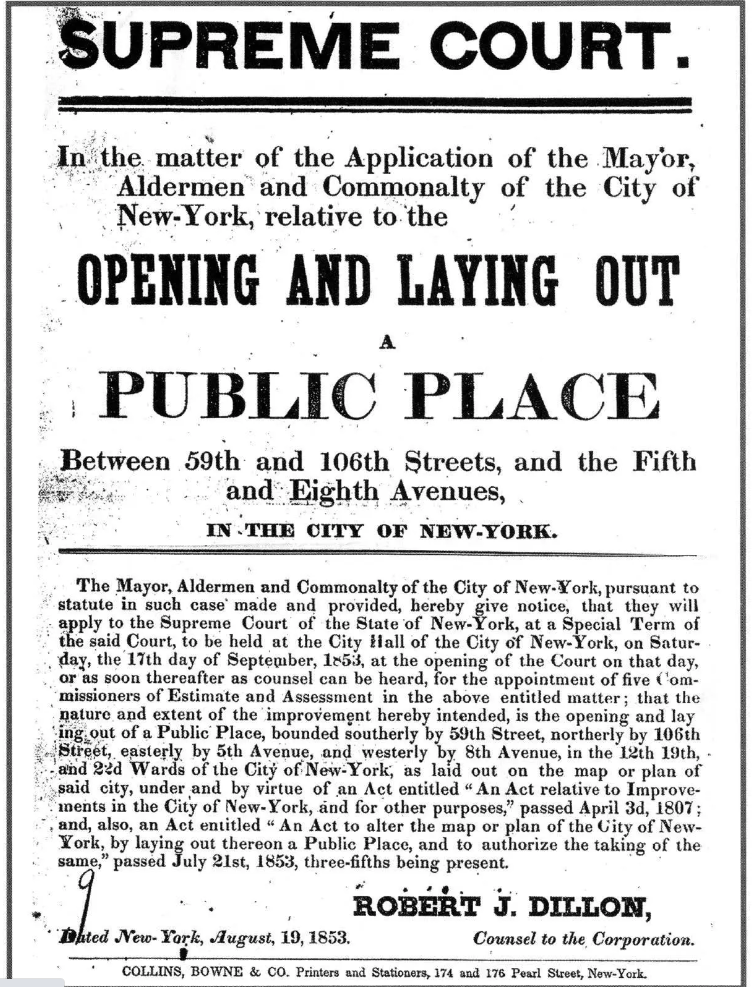On August 19, 1853, the mayor, aldermen, and commonality of the City of New York announced an appeal to the state’s Supreme Court for the “opening and layout” of a “public place between 59th and 106th Streets and Fifth and Eighth Avenues in the [uptown] 12th, 19th, and 22nd Wards.”[1] Earnest appeals for a public park first surfaced in 1844, when William Cullen Bryant—poet, journalist, and editor of the New-York Evening Post—called for an “extensive pleasure ground” in New York City, and one that matched “the greatness of our metropolis.”[2] “Commerce is devouring inch by inch the coast of the island,” Bryant warned, “and if we would rescue any part of it for health and recreation, it must be done now.”[3] “The only objection which we can see,” he prognosticated, “would be the difficulty of persuading the owners of the soil to part with it.”[4] That remark proved to be prescient.
Four years later, Andrew Jackson Downing echoed the call for a park. Downing was the foremost landscape designer in the young nation, a drafter of the prodigious grounds of the White House and the Smithsonian, and a contributor to the design of the Washington Mall. The ambitious Downing also had his designs on New York City. “What are called parks in New-York,” he scoffed, “are not even apologies for the thing.” [5] A well-designed park in the divided and frenetic city would, he claimed, “soften and humanize the rude . . . and give continual education to the educated,” and thereby serve all classes.[6] A park, he noted, could unite the class-conscious and divided city.
The first plan for an urban oasis in 1853, was a $1.5 million conversion of a 153-acre privately owned plot of land.[7] Jones Wood, as it was called, was on the East River between Sixty-Sixth and Seventy-Seventh Streets.[8] It belonged to two affluent families, the Jones and Schermerhorns, so vehemently opposed to a coerced acquisition through eminent domain that they appealed to the courts.[9] William C. Schermerhorn asserted that eminent domain was a “persecution” of him and his family.[10] The government’s role, he argued, was to safeguard, not seize his private property.
A New York County judge declared the bill to acquire Jones Woods unconstitutional.[11] While some leaders continued their advocacy, others set their sights on a larger, more central location on the border of communities known as Harlem, Bloomingdale, and Yorkville—comprised mainly of immigrants and African Americans.[12] The 778-acre rugged, swampy land was enormous, more than five times the size of Jones Wood. Many believed the land could be acquired and converted into a spectacular parkland for roughly the same $1.5 million cost.[13] Moreover, 135 acres already belonged to the Municipal Corporation of New York, and the rest could be acquired through the state’s right of eminent domain.[14]
The new Central Park board insisted that under eminent domain, the “citizen” is protected from “injustice.”[15] “He is,” they continued,” protected in the enjoyment of his property, unless the public needs it.”[16] Unlike the Jones and Schermerhorns who fought the surrender of Jones Woods, the African Americans and immigrants inhabiting the future Central Park—including those in Seneca Village—had little access to the court system to fight the justification of that “need.”
[1] “Handbill declaring the intended construction of Central Park,” in “Seneca Village: A Teacher’s Guide Using Primary Sources in the Classroom,” New-York Historical Society, 2010, 13, Collection of The New York City Municipal Archives, Bureau of Old Records, https://nyhs-prod.cdn.prismic.io/nyhs-prod/05a15797-cc2c-4360-a804-0bae8d3cec80_Seneca_Village_NYHS.pdf.
[2] William Cullen Bryant, “A New Public Park,” Evening Post (New York, NY) July 3, 1844, 2, https://newscomwc.newspapers.com/image/32119902.
[3] Ibid.
[4] Ibid.
[5] Andrew Jackson Downing, Rural Essays (New York: Leavitt & Allen, 1853), 485, Google Books, 2009, https://www.google.com/books/edition/Rural_Essays/MSa8zQEACAAJ?hl=en.
[6] Ibid., 142.
[7] Rosenzweig and Blackmar, Park and the People, 45.
[8] Ibid.
[9] Ibid., 45–49.
[10] Ibid., 50.
[11] Ibid. 50–53.
[12] Ibid., 60; Sara Cedar Miller, Before Central Park (New York: Columbia University Press, 2022), 193, Kindle; “A small branch” of the Methodist African Union met in the area slightly before 1846, but “with no distinct organization” of note. See: Jonathan Greenleaf, History of the Churches of All Denominations in the City of New York (New York: E. French, 1846), 328, HathiTrust, https://babel.hathitrust.org/cgi/pt?id=uc2.ark:/13960/t05x27q2p&view=1up&seq=5.
[13] Rosenzweig and Blackmar, Park and the People, 59.
[14] Ibid., 45; Besides the 135 acres of public land which accommodated a receiving reservoir, the rest belonged to 561 landowners. Twenty percent of the property belonged to only three families. The 34,000 lots ended up costing $5 million—more than three times the estimated $1.5 million cost for the entire park, including land and construction. See: Burrows and Wallace, Gotham, 792.
[15] “Report of Special Committee on Public Parks, January 2, 1852,” in First Annual Report on the Improvement of Central Park (New York: Chas. W. Baker, Printer, 1857), 104, Historical Vital Records of New York City, http://nyc.gov/html/records/pdf/govpub/4055annual_report_manhattan_central_park_1857.pdf.
[16] Ibid.










